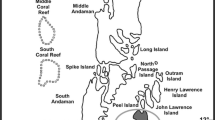Abstract
The species composition and distribution of marine plants on the fringing reef of Secoko Island were studied before and after the mass coral mortality in 1998. The study showed that changes in the bottom communities that occurred after bleaching of corals were caused by the presumed development of marine plants substituting reef-building corals on the bottom. The number of algal species grew from 211 to 345. The projective cover (PC) of hard substrate with macroalgae increased: in 1998, it was 1–10% in the subtidal zone and 20–50% in the intertidal zone, while in 2002 through 2005, the PC reached 71% in the subtidal and 40–85% in the intertidal zone. It is assumed that the phase of the “plant reef” on Sesoko Island is a temporary event, and that the coral reef can recover within several decades, unless a natural catastrophe occurs again.
Similar content being viewed by others
References
Sorokin, Yu.I., Ekosistemy korallovykh rifov (Ecosystems of Coral Reefs), 3/4.: Nauka, 1990.
Abrar, M. and Efendy, Y., Coral Recovery After Bleaching in 1998 at West Sumatra Waters, Indonesia, Abstracts. 10th Int. Coral Reef Symp., 2004.
Brown, B.E., Coral Bleaching: Causes and Consequences, Coral Reefs, 1997, vol. 16, pp. 129–138.
Diaz-Pulido, G. and McCook, L.J., The Fate of Bleached Corals: Patterns and Dynamics of Algal Recruitment, Mar. Ecol. Progr. Ser., 2002, vol. 232, pp. 115–128.
Hasegawa, H. and Yamano, H., Ishigaki Island, Coral Reefs of Japan. Ministry of the Environment; Jap. Coral Reef Soc., 2004, pp. 212–218.
Hughes, T.P., Catastrophes, Phase Shifts, and Large-Scale Degradation of Caribbean Coral Reefs, Science, 1994, vol. 265, pp. 1547–1551.
Iwao, K., Kerama Islands, Coral Reefs of Japan. Ministry of the Environment; Jap. Coral Reef Soc., 2004, pp. 185–189.
Kajiwara, K. and Matsumoto, H., Miyako Archipelago, Coral Reefs of Japan. Ministry of the Environment; Jap. Coral Reef Soc., 2004, pp. 204–208.
Littler, D.S. and Littler, M.M., South Pacific Reef Plants, Offshore Graphics, Inc., 2003.
Loya, Y., Sakai, K., Yamazato, K. et al., Coral Bleaching: the Winners and the Losers, Ecol. Lett., 2001, vol. 4, pp. 122–131.
McClanahan, T.R., Muthiga, N.A., and Mangi, S., Coral and Algal Changes After the 1998 Coral Bleaching: Interaction with Reef management and Herbivores on Kenyan Reefs, Coral Reefs, 2001, vol. 19, no. 4, pp. 380–399.
McCook, L.J., Competition Between Corals and Algal Turfs Along a Gradient of Terrestrial Influence in the Nearshore Central Great Barrier Reef, Coral Reefs, 2001, vol. 19, pp. 419–425.
McCook, L.J., Jompa, J., and Diaz-Pulido, G., Competition Between Corals and Algae on Coral Reefs: a Review of Evidence and Mechanisms, Coral Reefs, 2001, vol. 19, pp. 400–417.
Nakano, Y. and Nakamura, S., Annual Record of Coastal Observation at Sesoko Marine Science Center in 1991, Galaxea, 1993, vol. 11, pp. 173–181.
Nonaka, M., Daito Islands, Coral Reefs of Japan. Ministry of the Environment; Jap. Coral Reef Soc., 2004, pp. 199–201.
Pichon, M., Seguin, F., Hernandez, S. et al., Status of the Coral Reefs of Mayotte Islands (SW Indian Ocean) Five Years After the 1998 Bleaching Events, Abstracts. 10th Int. Coral Reef Symp, 2004.
Sakai, K., Okinawa Island, Coral Reefs of Japan. Ministry of the Environment; Jap. Coral Reef Soc., 2004, pp. 182–184.
Sakai, K., Muko, S., Nishikawa, A. et al., Coral Recruitment and Recovery of Coral Communities After 1998 Mass Coral Bleaching Around Okinawa Island, Abstracts, 10th Int. Coral Reef Symp., 2004, p. 135.
Titlyanov, E.A., Titlyanova, T.V., and Yakovleva, I.M., Competitive Relationships Between Algae and Coral Polyps Communities Under Direct and Indirect Contacts on Damaged Corals, Abstracts, 10th Int. Coral Reef Symp., 2004, p.135.
Titlyanov, E.A., Titlyanova, T.V., Yakovleva, I.M. et al., Regeneration of Artificial Injuries on Scleractinian Corals and Coral/Algal Competition for Newly Formed Substrate, J. Exp. Mar. Biol. Ecol., 2005, vol. 323, pp. 27–42.
Veron, J.E.N., Corals of Australia and the Indo-Pacific, Angus and Robertson Publishers, 1986.
Author information
Authors and Affiliations
Additional information
Original Russian Text © O.S. Sergeeva, T.V. Titlyanova, E.A. Titlyanov, 2007, published in Biologiya Morya.
Rights and permissions
About this article
Cite this article
Sergeeva, O.S., Titlyanova, T.V. & Titlyanov, E.A. Species composition and distribution of algae on the fringing coral reef of Sesoko Island (Ryukyu Archipelago) before and after the natural catastrophe of 1998. Russ J Mar Biol 33, 30–42 (2007). https://doi.org/10.1134/S1063074007010038
Received:
Issue Date:
DOI: https://doi.org/10.1134/S1063074007010038



